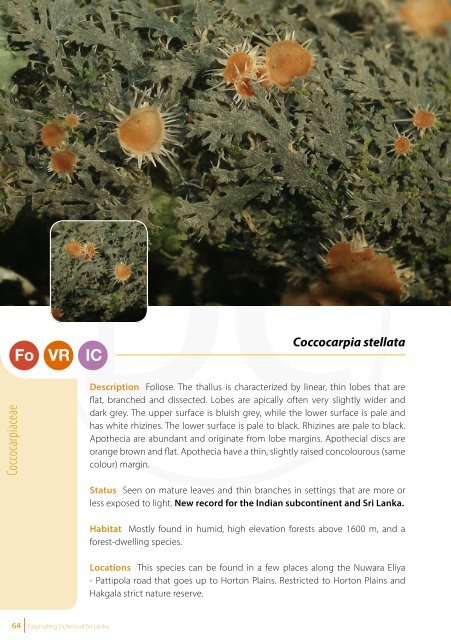Create successful ePaper yourself
Turn your PDF publications into a flip-book with our unique Google optimized e-Paper software.
Coenogonium<br />
Pixie-hair lichens<br />
Ostropales Coenogoniaceae<br />
80<br />
Coenogonium is a genus that mainly occurs in the subtropical and tropical<br />
regions <strong>of</strong> the world. The genus consists <strong>of</strong> species with a green to greyish<br />
green crustose or filamentous thallus. Most filamentous species <strong>of</strong> Coenogonium<br />
consist <strong>of</strong> lichenized filaments <strong>of</strong> Trentepohlia (green alga) which are similar in<br />
appearance to unlichenized Trentepohlia, which are present in the same habitats.<br />
It is therefore essential to find thalli for filamentous species with fruiting bodies,<br />
not only to be able to name the species but also to be sure you have a lichen.<br />
Only few species are known from <strong>Sri</strong> <strong>Lanka</strong> up to date, the most common <strong>of</strong> which<br />
tends to be a pantropical species. Recent research by Weerakoon and Aptroot<br />
(2014) documented a new record <strong>of</strong> this genus for the Indian subcontinent and<br />
<strong>Sri</strong> <strong>Lanka</strong>.<br />
Coccocarpiaceae<br />
Fo<br />
VR<br />
IC<br />
Coccocarpia stellata<br />
Description Foliose. The thallus is characterized by linear, thin lobes that are<br />
flat, branched and dissected. Lobes are apically <strong>of</strong>ten very slightly wider and<br />
dark grey. The upper surface is bluish grey, while the lower surface is pale and<br />
has white rhizines. The lower surface is pale to black. Rhizines are pale to black.<br />
Apothecia are abundant and originate from lobe margins. Apothecial discs are<br />
orange brown and flat. Apothecia have a thin, slightly raised concolourous (same<br />
colour) margin.<br />
The <strong>Sri</strong> <strong>Lanka</strong>n species are distinctive epiphytes that occur on smooth-barked<br />
trunks, and on mossy rocks <strong>of</strong> sub-montane, and montane forests throughout<br />
undisturbed, high elevation, humid areas.<br />
Species known from <strong>Sri</strong> <strong>Lanka</strong> are overlooked and need taxonomic revision.<br />
Studies are also needed to collect and identify the total diversity <strong>of</strong> this genus<br />
in <strong>Sri</strong> <strong>Lanka</strong>, as it can be assumed that many more species remain undiscovered<br />
in similar habitats.<br />
Apothecia common, sessile, convex to flat, disc yellowish to pale orange brown;<br />
Asci: mostly 8-spored; Spores: colourless, ellipsoid, 1-2 celled.<br />
Chemistry No lichen substances.<br />
Coenogoniaceae<br />
Status Seen on mature leaves and thin branches in settings that are more or<br />
less exposed to light. New record for the Indian subcontinent and <strong>Sri</strong> <strong>Lanka</strong>.<br />
Habitat Mostly found in humid, high elevation forests above 1600 m, and a<br />
forest-dwelling species.<br />
Locations This species can be found in a few places along the Nuwara Eliya<br />
- Pattipola road that goes up to Horton Plains. Restricted to Horton Plains and<br />
Hakgala strict nature reserve.<br />
64 <strong>Fascinating</strong> <strong>Lichens</strong> <strong>of</strong> <strong>Sri</strong> <strong>Lanka</strong><br />
<strong>Fascinating</strong> <strong>Lichens</strong> <strong>of</strong> <strong>Sri</strong> <strong>Lanka</strong> 65















